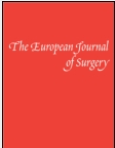Treatment of pilonidal sinus by primary closure with a transposed rhomboid flap compared with deep suturing: a prospective randomised clinical trial
Abstract
Objective:
To assess two techniques of primary closure after excision of pilonidal sinus.
Design:
Prospective randomised study.
Setting:
University department of surgery, United Arab Emirates.
Subjects:
46 patients with chronic pilonidal sinus disease, 24 treated by rhomboid flap transposition, and 22 by deep suturing technique.
Main outcome:
Early mobility and recurrence.
Results:
All patients in the rhomboid flap transposition group healed their wounds primarily compared with 17 in the primary deep suturing group (77%).
(P = 0.02). Five patients wounds broke down as a result of haematoma and infection (23%). The mean hospital stay for the rhomboid flap technique was 6 days compared with 9 days after deep suturing, and the mean follow up for both groups was 18 months, the rhomboid flap group returned to work a mean of nine days earlier than the deep suturing group (23 days). No recurrence has been identified yet in the rhomboid flap group, while 2 recurrences have developed in the deep suturing group (9%).
Conclusion:
Primary closure after excision of pilonidal sinus with a transposed rhomboid flap is successful in the management of pilonidal sinus and is superior to primary closure by deep suturing. Copyright © 1999 Taylor and Francis Ltd.




